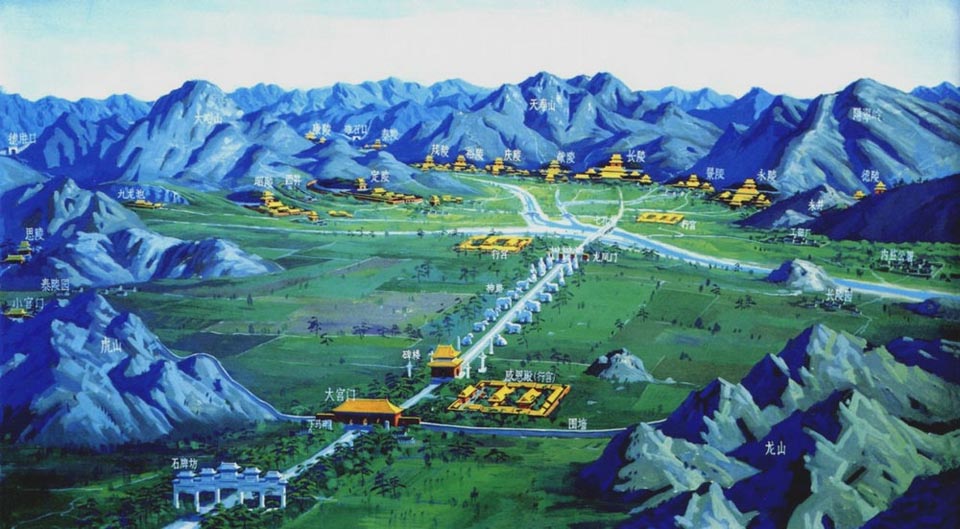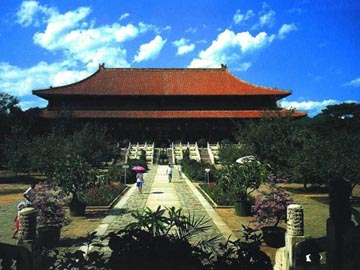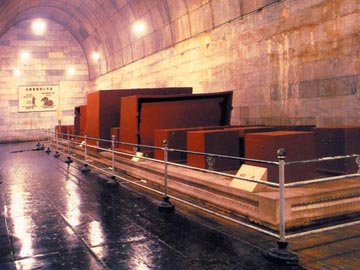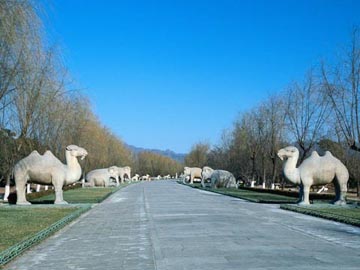|
 |
Ming
Tomb Layout |
More Stories about Imperial Tombs
The Evolution of Imperial Tombs Since the concept of
soul came into being, the human being began to build tombs. According
to the ranking of the people, their tombs were different. Of course the
monarchs’ mausoleums were the most magnificent. In different dynasties
the mausoleums of the upper class were different in the building forms.
Thousands years ago the tombs were very simple, no grave mound built and
no trees planted in the tomb area.
In the Qin and Han Dynasties, the tombs of the emperors were called “Fangshang”.
The grave mound was rammed into a pyramid without the upper part. Emperor
Qinshihuang’s tomb in xi’an was very representative. In the Tang Dynasty,
the emperor took the mountain as tomb so as not to waste money and manpower.
At the same time, that would conserve water and soil and keep the tomb
from being robbed. The Tangqian Tomb in Shanxi Province was a good example.
In the Song Dynasty, the emperors resumed the “Fangshang”, but the scale
was much smaller. In the Yuan Dynasty, The Mongols were the rulers in
China. The emperors were buried in a very special way. They were buried
under the grassland without grave mound or other buildings. In the Ming
and Qing Dynasties the “Precious city and precious top” prevailed. For
this kind of tombs, the underground palace made of stone blocks was covered
with earth and the brick wall surrounded the Soul Tower and the grave
mound. A stele carved with the emperor’s posthumous title was erected
in the soul tower. There were other buildings in the mausoleum area, such
as tomb gate, the sacrificial gate and the sacrificial hall and so many
cypresses were planted in the tomb area. Actually the mausoleum is much
like a real palace, magnificent and solemn.
The Burial Customs of Chinese
According to different ethnic groups, the burial rituals are too much
different. In Tibet and Mongolia, their burial ritual is called “Heavenly
Burial”. The corpse would be placed on a mountain to let the vultures
eat. That is to say the soul would go to heaven by this way. In south
China, the people used a way called “Water Burial”. The dead body would
be thrown to river to let fish eat it. In some minority groups, the remains
would be cremated. For most of our Han people, they would be buried under
earth. Today for most people will use cremate in order not to waste land.
 |
 |
| The
Sacrificial Hall |
The
Soul Tower |
 |
 |
The
Underground Palace |
The
Sacred Way |
The Funeral Rites After the death of the emperor, burial
rites with detailed procedures would be worked out by the Department of
Rites. The coffin would be placed in a palace hall. On the previous day
before the burial ceremony, a grand hearse would be set up in from of
the Meridian Gate with all articles necessary for the funeral processions
displayed in neat order. The newly enthroned emperor would take queens,
concubines, princes and other royal family members to have the sacrificial
ceremony. On the day of funeral, the sacrifice would be held in the Ancestral
Temple. On the day of burial the final farewell sacrifice would be held
at the Meridian Gate but the new emperor would not go any further. The
other royal family members and officials would accompany the coffin to
the tomb area.
On the way to the tomb area, a lot of sacrificial altars were set up for
the relatives of the royal family and hereditary family and officials
to pay homage to the deceased emperor, but no populace was permitted to
join in. When the coffin arrived at the tomb area it would be put in the
Sacrificial Hall. A ceremony would be held to appease the soul of the
dead emperor. Then the coffin would be buried in the underground palace
and the funeral ritual was finished.
Gold well and Jade burial It was the highest rank of
burial rite. That means to leave a rectangular hole on the coffin bed;
within it put a double handful of earth gathered from breaking the ground
at the building ceremony of the tomb and jade material put around the
coffin. It was said that the positive and the negative could be combined
by this way and the corpse would not be decayed.
The Excavation of the Ding Tomb
Authorized by the State Council the excavation started in May 1956. During
the exploration, the archeologists found mortar pieces on the outside
of the tomb wall fallen off, exposing signs of a brick gate collapsed
in the inner side. Later they found inscriptions such as “tunnel gate”,
“central axis” and “right passage” on the inner side tomb wall. All this
offered very important clues for excavation. So they dug the first tunnel
of 20 meters long and 3.5 meters wide. Two months later they found another
brick passage leading to the Soul Tower. So the second tunnel with 10
meters wide was dug. When they dug 30 meters long they found a stone tablet
with an inscription:” from here to the diamond wall is 40 meters away
with 11.5 meters deep”. So the third tunnel with 40 meters long and 11.5
meters deep was dug. At last they found the so-called “Diamond Wall” slanting
slightly inwards, narrow on top and wide at bottom. The archeologists
spent more than one year on excavating the tomb. You may ask why there
so many bricks carved with words and marks. The reason is that the tomb
was built many years before the emperor died. When the project was completed,
the passage leading to the burial chamber would be filled. In order to
find the way leading to the Under Ground Palace easily for the emperor’s
burying, the builders left these marked bricks.
Automatic Stone in the Ding Tomb The door of the underground
palace was closed from behind with the automatic stone propped. For example,
the door leaves were first brought passing the stone slot on the ground,
leaving a gap for the workman to slip out. Then the automatic stone was
made standing in the slot and it was held by a special clutch. Finally
the door was shut up behind the workman and the automatic stone fell into
the slot cut beforehand on the back of the door leaves. So the automatic
stone kept the door fastened from being pushed open from outside.
Tour guide Richard
Email: chinasilkrug@msn.com
Phone: 0086-13501103837
Wechat:13501103837
Other tourist attractions in Beijing